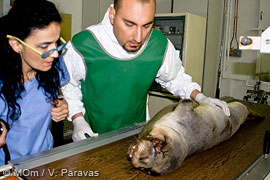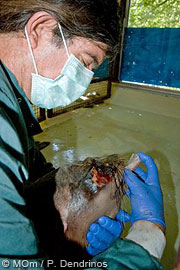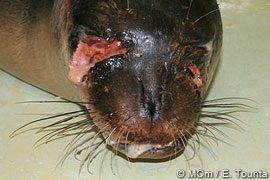

 |
||
 |
||
Vol. 13 (1): June 2010 |
||
Markos’s Case: Trauma, Treatment, and ReflectionsEmily JosephMOm/Hellenic Society for the Study and Protection of the Monk Seal
|
 |
|
|
Veterinarian Natassa Komninou and Alexandros Karamanlidis of MOm examine ‘Markos’ at the Veterinary School of the University of Thessaloniki. |
Upon arrival, Natassa Komninou, MOm’s long-time veterinary advisor, closely examined Markos, the 4-month old male monk seal. It was confirmed that Markos had been shot by a gun at close range, with the bullet entering the left upper jaw (leaving a wound approximately 2cm in diameter), travelling directly through the skull, and exiting on the right side of the head, just below the right eye (and leaving a wound approximately 5.5cm in diameter). The right eye was visibly damaged beyond repair in addition to severe trauma to the nasal cavity. An x-ray taken the following day also confirmed a spherical fracture in the upper jaw. The injury was estimated to be 2-3 days old and the wounds were carefully cleaned and examined.
Despite the gruesomeness of the injuries, Markos remained remarkably stable: his blood work showed no remarkable abnormalities and he remained alert. This paradox, however, left many questions regarding his future. His left eye remained but it was swollen and the veterinarians were unable to determine if the seal would retain vision. In addition, the holes left by the bullet wound left his windpipe vulnerable to water entry and, combined with his fractured jaw, left veterinarians and MOm staff unable to assess whether the animal would be able to self-feed in the future. With at least some hope remaining that the animal could overcome his unimaginable obstacles, a unanimous decision was made to transport the animal to MOm’s Rehabilitation Centre in Steni Vala, Alonnisos to provide the seal with a chance at survival.
 |
|
|
Markos being force-fed at the MOm Rehabilitation Centre on Alonnisos. |
Markos arrived for rehabilitation on 30/4/2010. He was started on a therapy regime of antibiotics for both aerobic and anaerobic bacteria and also for pain management in addition to the regular cleaning of his wounds. It was also decided that the best means of feeding would be the force-feeding of tuna (Thunnus alalunga) fillets and then whole fish (Boops boops and Scomber scombrus) as long as the animal remained unable to free feed. The severity of his wounds was shocking: one could literally see daylight from one side of the head to the other and the exit wound had left a large gaping section that drained constantly and required careful and regular cleaning. The palette of his mouth had been burned, several teeth were broken, and he held his lower jaw approximately 1cm off centre, though he continued to breathe largely through his mouth for the duration of his treatment.
In the days that followed, Markos received intensive care. He was very weak, sleeping and remaining largely motionless unless provoked. During feedings and treatments, however, he would vocalize and struggle as best he could, at times showing remarkably quick reflexes and strength. By his second day at the centre (2/5/2010), Markos began to show some classic seal behaviours: rolling over, vocalizing, and exhibiting some curiosity as to his handlers and environment. He responded best when the pool was filled to approximately 20cm—enough water for him to splash in, but also a small enough quantity to allow him to hold his head out of the water and to balance on his fore flippers.
 |
|
|
“The severity of his wounds was shocking.” |
Many problems remained, however. The staff began to notice that Markos remained unresponsive to noise – reacting instead to strong vibrations and/or touch. It was also noted that he consistently held his hind flippers slightly to the left (though it was impossible to know if this was a result of injuries sustained). On 6/5, tapeworms were found in his faeces and, after the administration of a dewormer, a large (1cm wide by 30 cm long) tapeworm was recovered. Weigh-ins every 3 days also showed that he had not begun gaining weight despite consistent fish feeds. A second veterinary examination on 7/5 held more bad news: after the administration of a topical anesthetic, his left eye was opened to reveal a corneal edema and a prolapsed iris, limiting Markos’s sight prognosis to the ability to distinguish shadows in the best possible outcome. After noting the seal’s inability to hear, the veterinarians speculated that damage might also have been sustained in the inner ear and, when a test was performed by filling the pool just above the level where Markos could balance on his flippers, it soon became apparent that the force of the gunshot had also affected his balance.
So it seemed that after a week’s stay in the centre, many questions still needed answering. Markos was for all intents unable to see, hear, or smell. His ability to swim (and thus to free feed) was limited by the extent of his inner ear damage and the state of his wounds; and his ability to dive would possibly be impaired by the sinus cavity left where his nasal passage would have been. The seal was certainly unreleasable in the immediate future and it was impossible to know how long he would need to remain in captivity for definite determinations as to his quality of life and future to be made.
Unfortunately, those questions can only be left to speculation: on 10/5, the rehabilitation staff entered the unit to find the seal in distress and Markos passed away immediately following an epileptic fit. A necropsy was performed the following day and samples were dispatched to MOm’s collaborators at the University of Erasmus in Holland for closer examination. Both histological and virological analyses of the samples are currently underway.
MOm would like to extend its gratitude to the Bodossaki Foundation for its partial sponsorship of the Monk Seal Rescue and Information Network and to the private donors whose financial contributions made this effort possible. We would also like to thank Natassa Komninou, DVM and Stephania Danika, DVM and the Veterinary School of the University of Thessaloniki for their expertise and guidance. In addition, many thanks to Dr. Frances Gulland, Director of Veterinary Science at the Marine Mammal Center in Sausalito, California, for her valuable advice to the rehabilitation programme. A special acknowledgement must also be made to Guy Routh, a MOm volunteer, for his dedication and assistance in the Monk Seal Rehabilitation Centre.
This latest incidence of brutality along with the rising number of seal deaths thus far in 2010 is deeply saddening and concerning. In 2008, MOm, in collaboration with the WWF Greece and the Fisheries Research Institute of Kavala, completed a 3-year, EU-funded research effort to investigate monk seal/fisheries interactions. In light of the data collected, the “National Strategy and Action Plan for the Conservation of the Mediterranean Monk Seal in Greece,” a report that includes specific and feasible institutional, technical, and financial measures to mitigate negative interactions, was formally presented to the Greek Ministries of Environment and Fisheries in July 2009. The Minister of Agriculture and Environment has also been informed of the recent cases of brutality towards monk seals and we are currently awaiting a response. We hope that Markos’s case can serve as a rallying cry, focusing public awareness on the extent of the problems at hand and inspiring the urgent action necessary to protect this critically endangered species before it’s too late.
Copyright © 2010 Emily Joseph, The Monachus Guardian. All Rights Reserved |